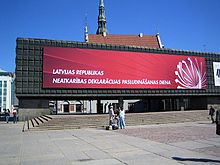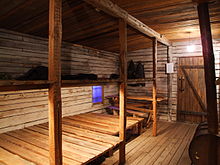- Museum of the Occupation of Latvia
-
Reconstruction of shack from Gulag in museum

Museum of the Occupation of Latvia 1940-1991 (Latvian: Latvijas okupācijas muzejs) is an historic educational institution located in Riga, Latvia. It was established in 1993 to exhibit artifacts, archive documents, and educate the public about the 51-year period in the 20th century when Latvia was successively occupied by the USSR in 1940, then by Nazi Germany in 1941, and then again by the USSR in 1944.
The museum's stated mission is to:
- "Show what happened in Latvia, its land and people under two occupying totalitarian regimes from 1940 to 1991;
- "Remind the world of the crimes committed by foreign powers against the state and people of Latvia;
- "Remember the victims of the occupation: those who perished, were persecuted, forcefully deported or fled the terror of the occupation regimes."[1]
Official programs for visits to Latvia of top level representatives of other countries normally include a visit to the Museum of the Occupation [2].
The building of the museum was built already in 1971 to celebrate Lenin's 100th birthday and up until 1991 it served as the Museom of Red Latvian Riflemen.
See also
- Soviet Occupation Day, Latvia
References
- ^ The Museum of the Occupation of Latvia, Occupation Museum Foundation, Riga (2005).
- ^ "Apmeklētāji" (in Latvian). Museum of the Occupation of Latvia. http://www.omf.lv/index.php?option=com_content&task=view&id=22&Itemid=26. Retrieved 2009-03-08. "Muzejs ir iekļauts Latvijas Valsts diplomātiskajā protokolā un to apmeklē daudzu valstu vadītāji un oficiālas delegācijas."
External links
- Museum of the Occupation of Latvia 1940-1991 Official website
- Education Programme of the Museum of the Occupation of Latvia (in Latvian)
Coordinates: 56°56′50″N 24°06′23″E / 56.9470925°N 24.1063643°E
Categories:- Museums in Riga
- Museums established in 1993
- Latvian building and structure stubs
- European museum stubs
Wikimedia Foundation. 2010.



